Could we record our dreams?
Dreams are an amazing phenomenon,and considering the fact that we spend roughly one - third of our life sleeping and 6 years of our life dreaming,its quite curious that we often brush them aside to be quickly forgotten. Night after night,our brains still work to bring us some of the most incredible,bizarre,and often,seemingly random imagery and storylines. What are dreams? And like the many science fiction stories or movies,could we record and figure out what we're seeing while we're dreaming?
You may have heard people referring to 'brain waves' before,but have you ever stopped to think if these are actual waves,and do they carry information? Are brain waves similar to radio waves? Well,the answer is,yes,both brain and radio waves are forms of electromagnetic radiations - waves that travel at the speed of light. Everytime you think,thousands of neurons fire at the same frequency and generate a wave. These waves oscillate at around 10 to 100 cycles per second. Radio waves,on the other hand,oscillate at around 50 million to 1 billion cycles per second.
Scientists have used this phenomenon often to measure brain activity and interface the brain to electronic devices. It allows us to see which parts of the brain are active for different activities,and similarly,which parts of the brain are active during dreaming. Unfortunately,there is no device that exists to allow us to peer into the mind of a dreamer,or is there any?
Crazy as it sounds,scientists have created a technique to do just that. This mind - reading began with a functional MRI scanner,inside which subjects were shown simple pictures made up of black and white pixels. The software then finds patterns in the brain activity that corresponds to the specific images. For example,if a letter was shown,the software would record exactly how the brain reacted. After sufficient data,the subjects were then shown completely different images,and the software would predict and recreate what it thought the subjects were seeing.
Further studies began to use more complex visuals when the subjects slept. In this case,they first had the subjects asleep in an MRI and would then wake them up in the middle of dreaming,quickly asking them what they were dreaming about. They then used thousands of images from the internet to get a best approximation of what the subject was seeing,based on brain scans. After doing this nearly 200 times with each person,and plugging the information into a learning algorithm,the software was used to predict and generate their future dreams. Though by no means perfect,it was clear that the machine predictions were better than matching up with the dreamer's description.




Comments
Post a Comment